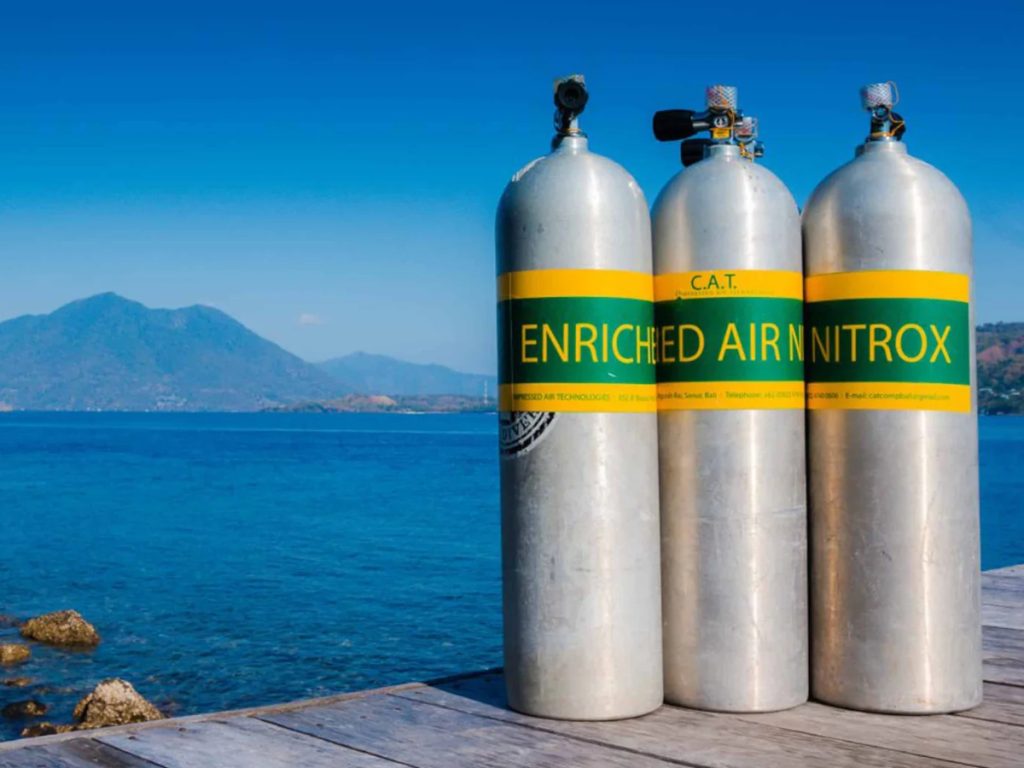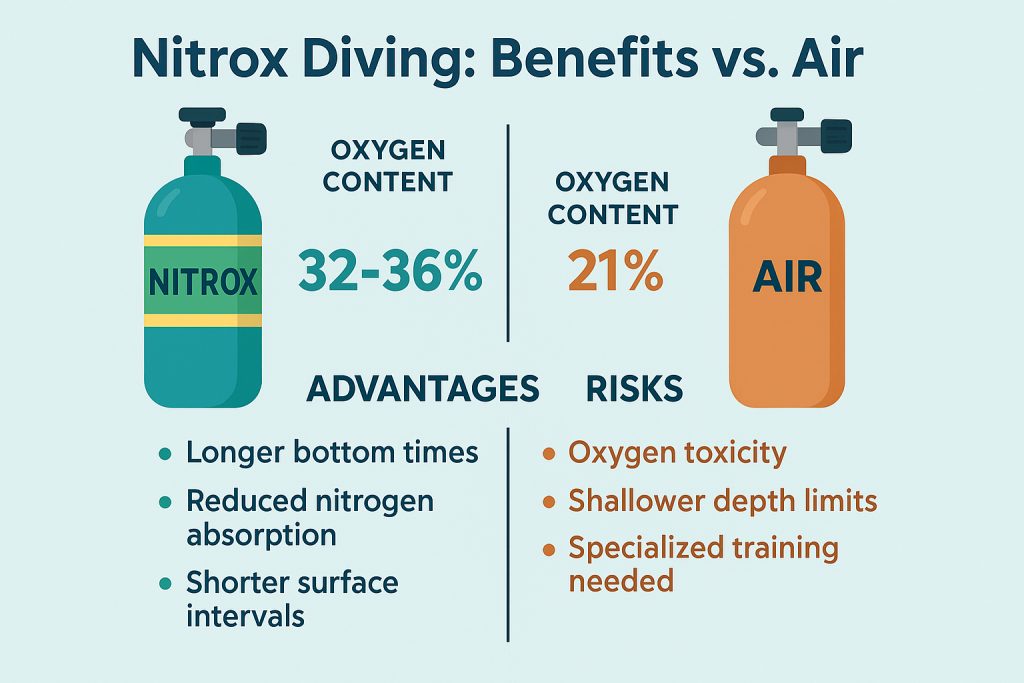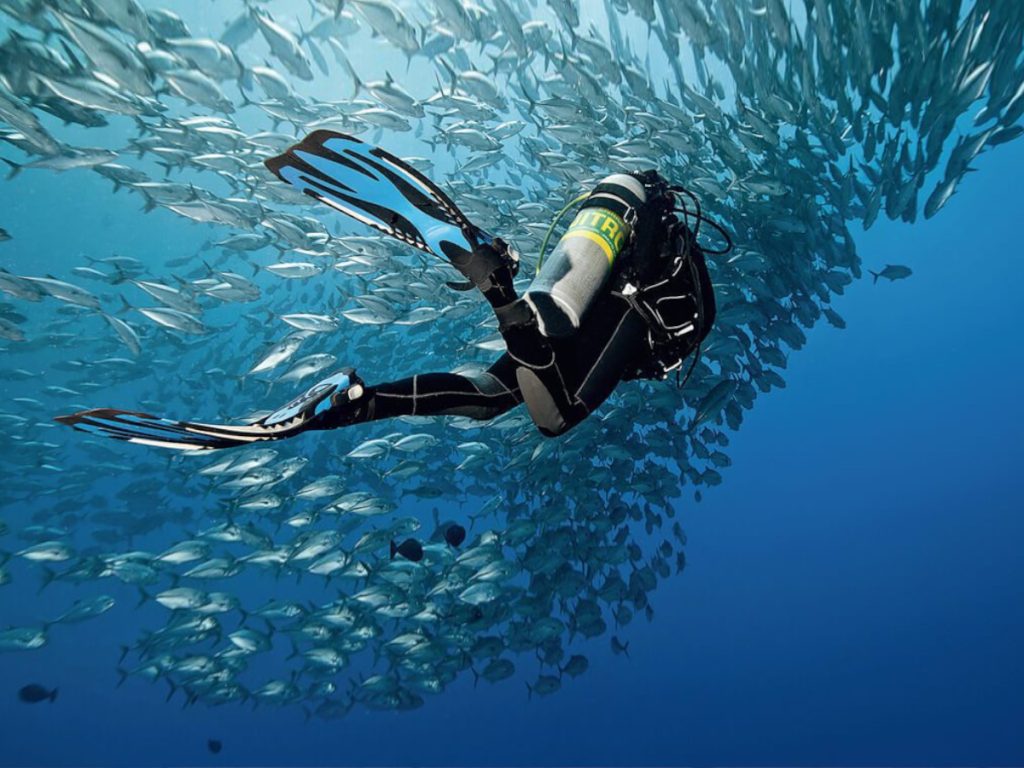In recent years, Nitrox Diving has become a popular choice among both recreational and professional divers. Known formally as Enriched Air Nitrox (EANx), this breathing gas contains a higher percentage of oxygen than regular compressed air.
By altering the oxygen–nitrogen ratio, Nitrox can provide longer bottom times and reduced nitrogen absorption, which can be especially valuable on liveaboard trips, photography dives, or any multi-dive schedule.

Organizations like the Professional Association of Diving Instructors (PADI), the Divers Alert Network (DAN), and the National Oceanic and Atmospheric Administration (NOAA) recognize the benefits of Nitrox Diving — but they also emphasize the importance of understanding its limits and risks.
What Is Nitrox Diving?
Traditional scuba cylinders are filled with compressed air, a mix of roughly 21% oxygen and 79% nitrogen.
In Nitrox Diving, the oxygen content is increased — typically to 32% or 36%, with the remainder being nitrogen. This change may seem small, but it has a significant impact on how your body absorbs gases under pressure.
Because there is less nitrogen in the mix, divers take in less nitrogen during the dive, which slows the rate of nitrogen accumulation in body tissues. Since nitrogen is the gas responsible for limiting no-decompression limits (NDLs), reducing it allows divers to stay longer underwater before needing to ascend.
How Nitrox Works
Every time you descend, the increased pressure causes more nitrogen to dissolve into your bloodstream and tissues. The deeper and longer you stay, the more nitrogen you absorb. Too much nitrogen, absorbed too quickly, raises the risk of decompression sickness (DCS) — also known as “the bends.”
Nitrox reduces this risk at certain depths by lowering the nitrogen fraction in the breathing gas. However, the trade-off is that with more oxygen, you face a different hazard: oxygen toxicity, which can cause convulsions underwater if limits are exceeded. This is why Nitrox divers calculate a Maximum Operating Depth (MOD) based on the oxygen percentage and the partial pressure limit they plan to follow.
For example, using NOAA’s recommended partial pressure of oxygen (ppO₂) limit of 1.4 ATA:
EAN32: MOD ≈ 33.7 m (110 ft)
EAN36: MOD ≈ 28.6 m (94 ft)
These values define the maximum safe depth to avoid oxygen toxicity.
Depth and No-Decompression Time
One of the biggest attractions of Nitrox is the ability to extend no-decompression time — but the effect varies depending on the depth. At shallow to moderate depths, the difference can be significant; at deeper depths, the MOD becomes the limiting factor.
While Nitrox is often associated with extended bottom times at moderate depths, it can also be beneficial for certain types of deep diving when used within its maximum operating depth limits. By reducing nitrogen absorption, it helps manage decompression obligations and can improve safety margins for planned deep dives, provided proper gas planning and training are followed
To illustrate, the following table shows the No-Decompression Limits (NDLs) for air and two common Nitrox mixes at the same depth. The numbers are drawn from the PADI Recreational Dive Planner and the NOAA Nitrox Tables.
| Gas Mix | Depth | NDL (minutes) |
|---|---|---|
| Air (21% O₂) | 18 m (60 ft) | 56 min |
| EAN32 | 18 m (60 ft) | 95 min |
| EAN36 | 18 m (60 ft) | 125 min |
As you can see, a diver on EAN36 at 18 m can spend more than twice as long underwater without requiring decompression stops compared to air.
Nitrox vs. Air: Key Differences

While both Nitrox and compressed air are made up of oxygen and nitrogen, the key lies in their proportions — and those differences influence how long you can stay underwater, how deep you can safely go during a Nitrox Diving, and what type of equipment and training you’ll need.
Nitrox typically contains more oxygen and less nitrogen than air, which reduces nitrogen absorption and allows for longer no-decompression times at certain depths. However, this increase in oxygen also imposes a shallower Maximum Operating Depth (MOD) to avoid oxygen toxicity, making dive planning more precise and sometimes more restrictive.
From an operational perspective, Nitrox Diving may require oxygen-cleaned cylinders and regulators, and divers must complete a Nitrox certification to learn how to calculate MOD, analyze gas mixtures, and adjust dive computers accordingly. Air, on the other hand, is universally available, cheaper, and allows for deeper dives — but at the cost of shorter bottom times and longer surface intervals when diving repeatedly.
The table below summarizes these differences side-by-side, offering a quick reference for divers considering which breathing gas is best suited for their specific dive profile. As you can see, Nitrox Diving has a lot of benefits, but also some risks that need to be considered.
| Feature | Nitrox (EANx) | Air |
|---|---|---|
| O₂ Content | 32–36% | 21% |
| N₂ Content | Lower | Higher |
| No-Decompression Limit | Longer at shallow/moderate depths | Shorter |
| Max Operating Depth | Shallower due to O₂ toxicity risk | Deeper (limited by nitrogen) |
| Equipment Needs | Requires O₂-cleaned tanks/regulators | Standard |
| Certification | Nitrox specialty course required | None |
| Cost | Slightly higher | Lower |
Before choosing one over the other, divers should consider the dive profile, water conditions, and their own training. In many situations, Nitrox provides clear benefits — but for deeper dives, air may be more practical due to MOD restrictions.
Advantages of Nitrox Diving
Nitrox is not a “magic gas” that makes you invincible underwater — safe diving still requires proper planning, monitoring, and adherence to depth limits. However, for certain types of dives and diving schedules, it can be a game-changer. Its altered oxygen-to-nitrogen ratio offers physiological and practical benefits that many divers find worth the additional training and cost.
Here are some of the key advantages:
- Extended bottom time at moderate depths
Because Nitrox reduces the nitrogen fraction in your breathing mix, your body absorbs nitrogen more slowly. This means that at depths shallower than your Maximum Operating Depth (MOD), you can often stay underwater significantly longer without hitting your no-decompression limit. For divers on photography, exploration, or relaxed reef dives, this can translate into more time to enjoy the experience. - Reduced nitrogen load for repetitive dives
Multiple dives in a day — such as those done on liveaboards or dive holidays — gradually increase nitrogen levels in your tissues. By starting with less nitrogen in each breath, Nitrox slows that build-up. Research by the Divers Alert Network (DAN) in 2020 found that divers using enriched air during multi-day trips showed a lower incidence of decompression-related symptoms compared to those using air. - Shorter surface intervals
Because you are carrying less nitrogen after each dive, your body requires less time at the surface before it’s safe to descend again. This can be particularly useful for dive operators running tight schedules, or for underwater photographers who want to make the most of favorable light conditions. - More time for task-oriented diving
Whether it’s conducting a marine biodiversity survey, inspecting a wreck, or patiently waiting for marine life to approach for a perfect photo, Nitrox gives you extra minutes to focus on the task without the clock ticking down as quickly as it would with air.
These benefits make Nitrox especially appealing for shallow to mid-depth diving, repetitive diving schedules, and situations where longer bottom times enhance both safety and enjoyment.
Disadvantages and Risk in Nitrox Diving

Like any tool, Nitrox has limitations:
- Oxygen toxicity risk if MOD is exceeded.
- Shallower maximum depth compared to air for the same ppO₂ limit.
- Special training requirement (Nitrox certification).
- Higher cost for fills.
- Oxygen-clean equipment needed for mixes over 40% O₂.
Real Nitrox Diving Profile Example
Numbers alone can feel abstract, so let’s look at a realistic nitrox diving scenario:
- Dive 1: 24 m (80 ft) for 35 minutes
- Surface interval: 1 hour
- Dive 2: 18 m (60 ft)
Using Air: Dive 2 NDL = 39 min
Using EAN32: Dive 2 NDL = 70 min
In this case, Nitrox gives you 31 extra minutes on the second dive — time that can be used for exploration, photography, or simply enjoying the marine life.
Safety Considerations of Nitrox Diving
While Nitrox can improve safety by reducing nitrogen exposure, it introduces other risks that require strict discipline and proper training. The benefits of enriched air only apply when divers follow established procedures and respect its limitations.
- Analyze your gas before every dive – Never assume the mix in your tank matches the label. Use an oxygen analyzer to confirm the exact percentage and record it in your dive log. This is your first line of defense against incorrect fills.
- Set your dive computer to the correct oxygen percentage – A computer configured for the wrong mix can give inaccurate no-decompression limits and MOD warnings, potentially leading to dangerous situations.
- Respect the MOD and oxygen exposure limits set by NOAA and DAN – Staying within these limits helps prevent central nervous system oxygen toxicity, a serious condition that can cause convulsions underwater.
- Maintain good overall health and fitness for diving – Proper hydration, rest, and physical conditioning reduce stress on the body, which is especially important when managing gas exposures and repetitive dives.
By combining enriched air with these disciplined practices, divers can enjoy Nitrox’s advantages while keeping the associated risks under control.
Summarizing Nitrox Diving
Nitrox Diving is a valuable tool for divers seeking longer bottom times and reduced nitrogen exposure, especially at moderate depths. By understanding both its benefits and limitations, divers can make informed choices that match their goals and safety requirements.
For a deeper understanding, divers should consult authoritative resources such as the PADI Enriched Air Diver Manual, the NOAA Diving Manual, and the DAN research archives.
